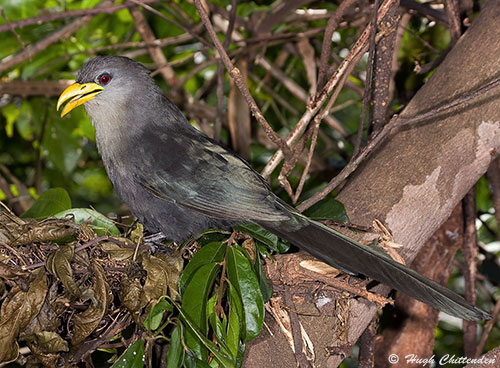Topic : Landbirds
Article 50 ![]() 23 April 2009
23 April 2009
Green Malkoha – breeding strategy
Green Malkoha Ceuthmochares aereus or Green Coucal as it used to be called in southern Africa, is about as elusive to birders as any other rare or uncommon forest species in South Africa. In fact, it could be listed as one of the ‘big 5’ on the most frustrating list of the ‘to see’ species. The name is quite misleading because although its wings, tail and lower back has a greenish sheen, the overall plumage colour is grey! Like the large group of south-east Asian malkohas (11 species) the African representative is a skulker that inhabits the vines and tangles of forests and forest margins.

Hyperolius frog prey brought to nest.
Habitat
Green Malkoha inhabits warm temperate forests and riverine thickest that afford them dense cover such as vines and creepers in which to crawl around in. They generally occupy the upper canopy of forests and seldom sit out on exposed branches making them particularly difficult to see.

Adult Green Malkoha
Nest
Unlike coucals, they don’t build domed or semi-domed nests. Their flat dove-like structures are constructed high in dense clusters of tangles and foliage. An interesting observation at this nest site was the use of fresh leaves to line the nest with during the incubation period. Coucals also use green leaves as lining during incubation. Both birds brought Climbing Flat-bean leaves Dalbergia obovata on a daily basis to line the nest, but this ceased once the eggs hatched. The nest was placed within the uppermost branches of Thorny Rope Dalbergia armarta and because of the absence of the sister species D. obovata in the immediate vicinity, the birds had to fly some distance to find the leaf species of their choice for nest lining.

Malkoha nest located in Dlinza forest, Eshowe, KwaZulu-Natal on the 30 th Oct 2007.
Female Malkoha brooding young chicks
Nest observations
Once the 22 m high nest was located, nest checks were kept to a minimum for fear of disturbing the birds. After the eggs had hatched, a nearby hide was constructed and nest observations took place for 6 days till unfortunately the nest was predated. Newly hatched young lack feathery down and are sparsely covered with reddish-brown wire-like hairs known as neossoptiles (young coucals have similar down bit generally whitish in colour). Because of the similarity of adult plumage, the role of brooding chicks could not definitely be allocated to one specific adult, but thought to be shared between both adults and probably dominated by the female. Young were fed with a wide range of vertebrates and invertebrates, including Hyperolius frogs, caterpillars, preying mantids, cicadas and spiders.

Invertebrate prey fed to chick.


